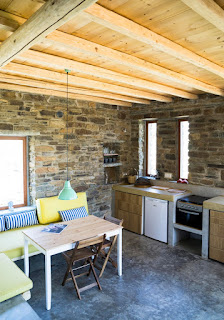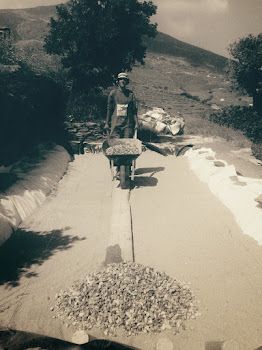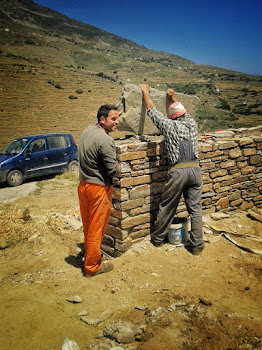Tinos eco lodge
it is about the design of an eco friendly tourist destination
Sunday, June 19, 2016
Saturday, February 6, 2016
Autumn Permaculture Design Course (PDC)
Led by Dr. Rod Everett and Mill Millichap
We are excited to announce the first FULL PERMACULTURE DESIGN COURSE (PDC) that will be hosted in Tinos Eco-lodge with two knowledgeable teachers and lifelong farmers from England, Dr. Rod Everett and his colleague Mill Millichap who are teaching permaculture since 1990 in various parts of the world and are coming to Greece and spreading the permaculture philosophy and way of life for the last 5 years.This PDC is fully certified by the Permaculture Association (Britain).
The Permaculture Design Certificate is a 72 hour theoretical course based on Bill Mollison’s Designers Manual, teaching how we can use today’s tools and technology to create a more sustainable world. Permaculture is not only about growing vegetables and animals, it is a whole sustainable lifestyle. Permaculture ethics are Earth Care, People Care and Return of Surplus and this is taught by showing students to focus on local resources and their local community, and to have well thought out design practices to create abundance sustainably. Anyone who wants to bring a big change in his life and way of thinking is welcome to participate, there is no need of previous knowledge of the subject.
At the Tinos Ecolodge you will have the opportunity to see stone built houses with local materials, an off-grid system for energy production for the whole lodge which is powered by solar panels, collection of rain water system, reedbed filtration sewage system, indoor compost toilets with the Aquatron separation system, outdoor compost toilets, outdoor kitchen and shower filtration systems and a lot more to be built and learned during the seminar.
Teachers
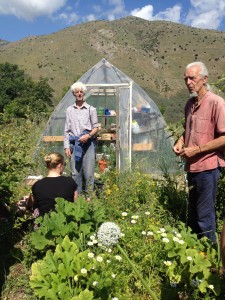
Whole body learning enables the permaculture principles to become an integral part of your life.
His great friend and co teacher Mill brings his knowledge and skill of growing food for many years and living a thoughtful and simpler life. He always adds his wealth of knowledge and enthusiasm for life to their joint courses.
www.rodspermaculture.co.uk
Accomodation and food
Tinos Ecolodge is situated in a beautiful island setting with great sea views and sunrise from the sea, traditional terraced landscape, with a nearby stream and lots of old oak trees to camp under. There is also limited space in the 2 lodges which can host up to 8 people. There will be a communal outdoor kitchen were we will eat all together 3 meals per day, and outdoor showers and compost toilets for those who camp. Max number of participants is 20 people.
Location
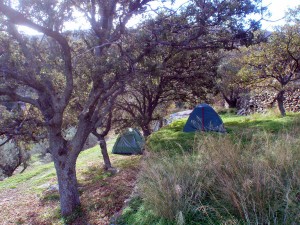
Cost: 550euro/tents and 650euro/houses, early bird reduction 100euro if booked until the 10th of July.
There will be also a special price for Greek participants which are suffering from the economic crisis at 350 early bird – 450euro/tent.
The price includes 3 meals, breakfast, lunch and dinner, 2 field trips, transport from the port of Tinos and back plus the PDC certificate.
Contact details
Marilia Kalouli, info@tinosecolodge.gr
Tel.0030 6974467611
Read more about the COURSE OUTLINE
Tuesday, October 20, 2015
Wednesday, September 16, 2015
Friday, July 24, 2015
Tuesday, June 9, 2015
Gardening
In the final sprint of completing the houses we couldnt resist to steel some time and construct a vegetable garden in the back of the plot. One of the stone workers passed one sunday with his two wheeled little red traktor and helped us to prepare the ground. The next week we planted tomatoes, peppers, water melons, honey melons, parsley, eggplants and zuchinis. The earth seems to be good because it was resting for a lot of years without cultivation. We collected a lot of humus from beneath the oak trees and animal waste out of the old stables to enrich the soil with organic material and microorganisms.........the little stream beside the garden has still a lot of water due to the heavy rainfalls of the winter, so irrigation comes naturally for the time being.
Saturday, May 16, 2015
Xerolithies - Dry stone walls
The dry stone walls that are built all over the island and stabilize for centuries the terraces are under threat! The fields are abandoned with no use anymore for cultivation and their walls are falling down because there is no one there to fix them. There was a rule that the neighbor from above is responsible for fixing the stone walls underneath. So here we are fixing our stone walls at the borders with the neighbor which were down for the last 4 decades!
Sunday, April 26, 2015
Wednesday, April 22, 2015
Saturday, April 11, 2015
Stone plates
We started our first expierience with laying stone plates. First attempt was to lay them in mud with this simple but time consuming technic we realized a pathaway and an sitting area under the mulberry tree at the small house. The second technic was to lay them into mortar. Its quiet a bit faster and much easier to level them to each other.




Thursday, April 9, 2015
Monday, February 23, 2015
The First to come
A million thanx go out to Joni the first who came, stayed and worked with us........for our dream. We will always remember the nice 3 months you spend with us. All the input to the project or how you would call it "company" lol......lets see what we can make out of it.
Sunday, February 22, 2015
Rain Water Cistern of 100.000L
In August the excavation started(pic.1) and we extracted about 30% of the stones we used for our buildings. After leveling the ground the wood shuttering for the concrete was put up(pic.2). Concrete was poured in September and the Greek magicians managed to make floor and walling in one run(pic.3-4). Iron reinforcement was put in place for the roof that also is making up the veranda of the one house(pic.4-6). Cleaning out all the mud, irons and water in the dark was a hell of a job. Finalizing the veranda (roof) surface with the power trowel and color worked out fine(pic.7-9). Finalizing the inner part of the cistern took us quite some time because all loose parts like wood, mud and nails had to be removed before the water impregnation could start. We used a cement based sealing slurry for drinking water quality, in 3 passes(pic.10-11).
At the moment water level is continuously raising with 50cm in 22.Feb.2015
Tuesday, February 10, 2015
Slow down with the weather
The weather finally permitted us to finish the roof and the terrace of the small house and the last wall of the big house. Now its time to construct the mold for the roof of the big house. We also started the drainage canal around the small house and we are preparing the molds for two more terraces. This winter is raining a lot which is good for the island but hard for the construction site....and we are left with only 3 workers, so things are going pretty slowly...the race for finishing in June for the ESPA funding will be hard, but we are still optimistic!!
Subscribe to:
Posts (Atom)





